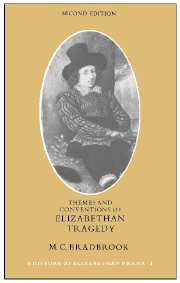Book contents
2 - CONVENTIONS OF PRESENTATION AND ACTING
Published online by Cambridge University Press: 08 January 2010
Summary
LOCALITY
The Elizabethan public theatre had a projecting main stage, with a small discovery space, closed by a curtain. Above was an upper space, sometimes with practicable windows. There were three doors at least to the main stage, with windows over the doors; and a third storey, the ‘top’ or ‘turret’, where the playhouse flag was hoisted. The stage was provided with several traps, and with means of descent from above, the ‘thrones’.
The chief characteristic of the Elizabethan stage was its neutrality and its corresponding virtue, flexibility. There was no inevitable scenic background, or any other localising factor, such as a chorus provides.
It followed that far more weight attached itself to the persons and movements of the actors. In short or unimportant scenes no indication of place is given, either by properties or by the speech of the actors, and no place need be assumed. It is the result of oversight rather than a deliberate device: the author was not compelled to locate his characters and, for a short scene between first and second gentlemen, there was no need to do so.
The scenes of a comedy were often located vaguely within a given town; and the short scenes of battle plays could all be covered by a general label.
- Type
- Chapter
- Information
- Themes and Conventions of Elizabethan Tragedy , pp. 8 - 28Publisher: Cambridge University PressPrint publication year: 1980

